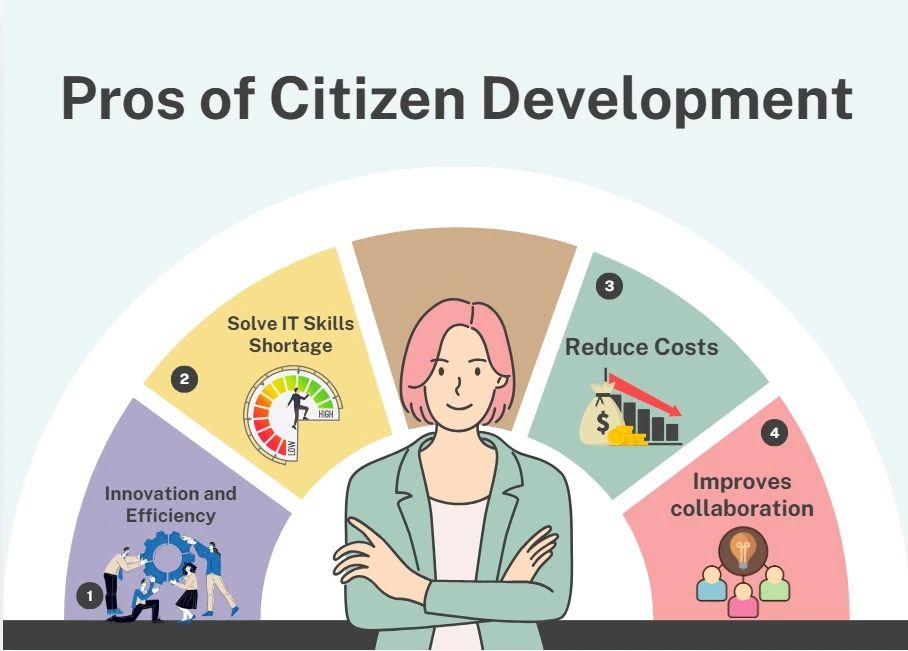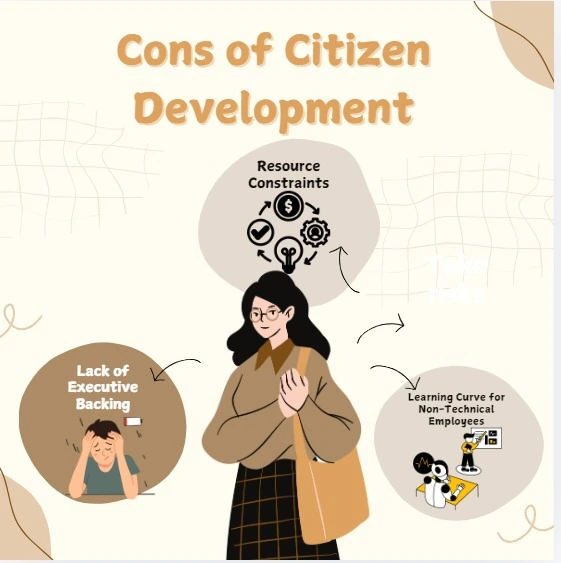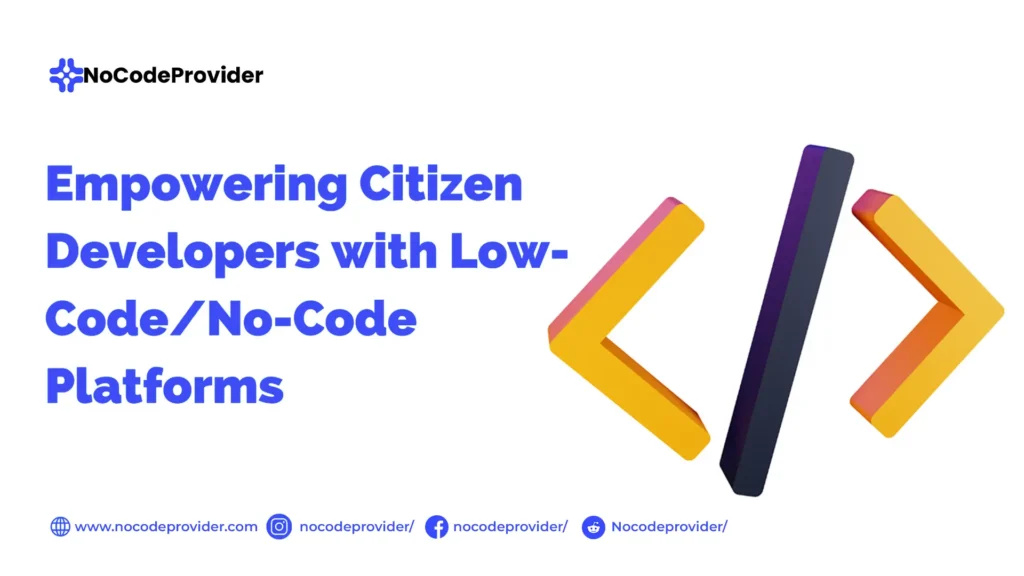Agility and innovation are crucial for success in today’s fast paced digital world. By leveraging no-code low code automation tools, citizen developers-non technical employees are driving rapid digital innovation in the software development industry.
Want to know how citizen developers and IT professionals team up for success?
Your business can innovate faster by combining the speed and business insight of citizen developers with the technical expertise of IT professionals. In this article, you will come to know the complete guide to become a citizen developer.
Who is a Citizen Developer?
A non-technical person who automates processes and develops applications is known as a citizen developer. They usually come from various departments including HR, Finance, Marketing etc.
Unlike traditional developers who have expertise in various programming languages, citizen developers use drag-and-drop interfaces and built in components to create applications easily and quickly.
By meeting the unique needs of teams and departments, citizen developers can help organizations to be more innovative, agile and responsive.
How Citizen Development Platforms are Changing the Game?
Citizen development platforms are changing the game by providing an easy-to-use drag and drop interface along with pre-built components to allow non-technical professionals to create applications and custom workflows. So creativity, efficiency and collaboration within companies gets boosted due to citizen development platforms.
No-code Citizen Development Programs are Bridging the IT Gap
No-code citizen development programs are bridging the IT gap as they facilitate and promote the development of applications and automation of workflows by non-technical professionals.By enabling faster delivery of applications, these platforms provide an efficient and cost effective solution.
Creativity & Problem-Solving Abilities: Key Citizen Developer Skills you need to build with No-Code
1. Problem-solving
To create practical solutions, analyze and identify business problems and gather requirements.
2. Creativity and design
To create visually appealing and user-friendly applications, think outside the box. Design prototypes and based on user feedback, refine them.
3. Data management and analysis
To create meaningful insights, apply data analysis techniques and work with data efficiently,
4. Communication and collaboration
To ensure the success of your project, you should communicate with stakeholders and collaborate with IT and other departments.
5. Learning and adaptability
Learn new tools and platforms and stay curious and up-to-date with technological trends.
6. Systematic Approach
To develop applications, make a structured plan and follow it. This helps in ensuring effective solutions.
7. Eye for Design
User experience gets enhanced by crafting intuitive and visually appealing interfaces.
8. Data Skills
Informed decision making can be empowered by ensuring proper data handling and integration into your applications.
9. Patience
For building high-quality products that meet user’s needs, you must become proficient in the iterative process of testing and refining applications.
10. Project Management Skills
Master the skills of managing time, resources and teams effectively to ensure project delivery within budget and time.
11. User Empathy
Build solutions that address end user’s needs and pain points.
How to Become a Citizen Developer in 7 easy steps
Step 1: Identify the problem or opportunity that Citizen Development can help address
The initial step is to identify the problem. Ask yourself what is the problem that I need to solve? After analyzing the problem, you should figure out whether I need a low-code platform or a no-code platform for the solution of it. No-code platforms are better suited for automating straightforward tasks or for simple applications, whereas low-code platforms are best for applications with a moderate level of complexity.
Example: Consider developing an app that automates data entry and reporting if your team is wasting hours manually entering data into spreadsheets.
Step 2: Choose a Citizen Development platform
Based on your requirements, the next step is to choose an appropriate platform. A number of no-code and low-code platforms are available in the market including Salesforce, Xano, Softr, Appian, Mendix, Bubble, Microsoft Power Apps and much more. You must consider factors like ease of use, customization and integration while selecting the platform and choose it according to your requirements.
Step 3: Learn the low-code no-code development platform
The next step is to learn the usage of the selected low-code no-code development platform. Most of these platforms provide a user-friendly interface and pre-built templates that are easy to customize. You can learn better by attending different trainings, courses, by joining multiple groups on social media and by hands-n-practice. You can start from the basics and then become an expert citizen developer as you get familiar with the platform.
Step 4: Identify the data source
A data source is where your data is stored. Before developing the application, you need to identify the data source and learn how to integrate it with your application. The data sources include those for storing internal data such as databases, Google Sheets, Excel, and external services like ERPs (Enterprise Resource Planning) and CRMs (Customer Relationship Management systems) . Make sure that sensitive information is handled with proper permissions and encryption.
Step 5: Build the application or automate the process
Building your application is the most exciting part of the entire process. Without writing complex code, you can develop user-friendly applications using built-in templates and drag-and-drop features. Processes like sending notifications or generating reports can be automated to make your app more efficient. So make sure to develop an application that meets the identified requirements.
Step 6: Test and deploy
The next step is to test your applications. Application can be tested in a sandbox environment to be checked for any bugs and to ensure that data flows correctly. For gathering proper feedback on usability and performance, real users must be involved in the testing phase. After testing and making necessary adjustments, you can deploy the application. Easy deployment options with few clicks are provided by most of the no-code low-code platforms .
Step 7: Maintain and update
To make sure your product remains effective, maintenance and updates are crucial. As platforms keep on releasing security updates and new features, you need to make sure that your application adapts to any changes in technology or workflows, runs smoothly and meets evolving business needs.
Citizen Developers VS Professional Developers: Collaborating for Success
Aspect
Citizen Developers
Professional Developers
Collaboration Benefit
Skill Level
Focused on specific tasks,business-oriented, non-technical
High technical expertise with in-depth coding and development knowledge
With technical precision, business insights can be combined
Tools Used
No-code and low-code platforms including Microsoft Power Apps, Quixy etc
Advanced programming languages and frameworks including C#, Java and Python etc
Uses the advantages of both simple and sophisticated development tools
Focus
For specific business problems, offer quick solutions
Developing secure, complex and scalable applications
Scalability can be done effectively with rapid prototyping
Speed of Development
Rapid development because of drag-and-drop interfaces and built-in templates
Development is slow but high customization and robustness is involved
For business needs, time-to-market is accelerated
Cost
Low cost as the need for full time developers is reduced
Costly as it requires time investment and specialized skill set
By assigning tasks to the right role, overall project cost is reduced
Problem Solving Approach
Concentrate on solving instant business challenges
Concentrate on long-term scalable solutions
A balance between long-term sustainability and fast fixes is created
Customization Capabilities
Within the constraints of no-code platforms, it is limited
Can build complex and highly customized systems as it is extensive
Flexibility is enhanced as citizen developers can take the initial step and IT can refine it
Security and Compliance
For security protocols and compliance requirements, there is limited knowledge
For security, compliance, and data management, there is strong understanding
For every project, makes certain that security standards are met
Collaboration Style
To meet instant needs, teams up with business stakeholders
For citizen developers, provides mentorship and collaborates with IT teams
Knowledge exchange and mutual learning is facilitated
Maintenance and Updates
There might be challenges for long-term maintenance and complex updates
Continuous technical updates, support and scaling is provided
Maintenance over time and sustainability for applications is made certain
Innovation Potential
Can quickly experiment, innovate and revolve to meet business demands
Ensures scalability and drives deep technical innovations
Combines depth of technical expertise with speed of innovation
The Best Tools for Non-Technical Professionals to Build Custom Applications
1. Microsoft Power Apps
A low-code platform with drag-and-drop interfaces and pre-made templates that lets users create unique business apps.
2. Google App Maker
Custom applications and workflows for G Suite can be created by using Google App Maker-a no-code platform with visual editor.
3. Quixy
A no-code platform that automates processes and streamlines workflows for driving digital transformation and improving efficiency in organizations of all sizes.
4. Quick Base
Using pre-built templates and integrations, workflows and custom applications can be built by using QuickBase-a low-code platform.
5. Salesforce Lightning
A low-code platform that allows you to build responsive and modern web applications on the Salesforce platform.
Pros and Cons of Citizen Development
Pros:

Cons:

What are the Challenges in the Implementation of a Citizen Development Project?
1. Governance and Control
Making sure there is appropriate governance is one of the biggest challenges. Unmonitored development could result in varying standards, non-compliance with legislation, and security risks if there are negligent policies and guidelines.
2. Resource Allocation
Resources like time, equipment, and training are needed to carry out a citizen development project. Inadequate planning may cause it to divert attention from essential company tasks or lead to an inequitable allocation of development resources.
3. Change Management
The organization’s culture must change in order to implement a citizen development project, giving non-technical staff members the authority to handle development responsibilities. IT departments that feel their function is being eroded and staff members who are uneasy with new tasks may oppose this change.
4. Metrics and Measuring Success
It can be challenging to gauge the effectiveness of citizen development programs. It is challenging to assess whether citizen-developed applications are adding value, resolving business issues, or saving money and effort without precise measurements and KPIs.
What are Some Real-life Examples of Citizen Development?
Ya Below 3 Points ke IMGs google sa find krka laga dana yad sa.
1. Coca-Cola Bottling Company
Utilized Platform: Microsoft Power Apps
Challenge: The manual inspection procedure of Coca-Cola Bottling Company’s network of vending machines was laborious and prone to mistakes, resulting in operational inefficiencies.
Solution: Citizen developers within the organization created a unique mobile app using Microsoft Power Apps, which enabled technicians to swiftly examine vending machines and log concerns using their smartphones while on the job.
Impact: By eliminating errors from manual data entry, the app shortened the inspection time and expedited the reporting process. This improved the effectiveness of operations and made maintenance actions visible in real time.
2. Toyota
Utilized Platform: Out Systems
Challenge: Toyota had to overcome the difficulty of coordinating team communications in order to manage their intricate supply chain. They required a solution that would streamline departmental communications and automate procedures.
Solution: Using the OutSystems low-code platform, Toyota’s citizen developers created custom apps to manage parts, automate workflows, and keep an eye on supply chain activity in real-time.
Impact: Toyota’s supply chain had faster operations, better communication, and a reduction in manual intervention as a result of the automated workflows, which enhanced manufacturing processes.
3. Unilever
Utilized Platform: Power BI & Power Apps (Microsoft Power Platform)
Challenge: Unilever intended to reduce the amount of human labor and data collection from multiple sources that were involved in its procurement process, which resulted in delays and irregularities.
Solution: Using Power Apps, Unilever’s citizen developers without a formal IT background built a procurement application that automates purchase orders and connects to Power BI for data tracking and analysis.
Impact: By delivering real-time data insights and cutting down on the time required to finish procurement processes, the app enhanced decision-making and increased overall efficiency.
Conclusion
Significant advantages, such as fostering innovation, solving IT skills shortages, reducing costs, and improving cross-department collaboration are offered by citizen development. In today’s digital age, becoming a citizen developer is an empowering method to improve efficiency, creativity, and productivity. By following the seven steps discussed in the article, you can drive innovation and become a valuable asset for your organization.
Ready to Unlock Innovation and Drive Business Growth?
Frequently Asked Questions (FAQs)
How do I choose the right low-code or no-code platform?
By considering your business needs, scalability, ease of use, and security features, you can select the right low-code or no-code platform.
What are the benefits of becoming a citizen developer?
Faster innovation, reduced reliance on IT and empowerment to create digital solutions are the benefits of becoming a citizen developer.
Do I need any technical skills to become a citizen developer?
No, most of the platforms provide a user-friendly and drag-and-drop interface which makes it easy for non-technical users to develop applications.
How can I continue to improve my citizen development skills?
By exploring new tools, participating in on-going training, collaborating with peers and hands-on-practice, you can continue to improve your citizen development skills.

